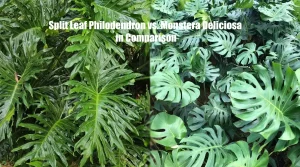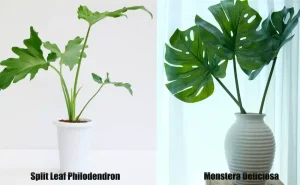The split leaf philodendron and monstera are popular houseplants for their unique and striking foliage. While they may appear similar at first glance, there are several key differences between these two plants that set them apart. In this article, let’s distinguish two to choose your suitable houseplants.

Introduction about Split Leaf Philodendron and Monstera Deliciosa
Origin of Split Leaf Philodendron and Monstera
Monstera and Philodendron are both types of indoor plants. They belong to the same Araceae family and originate from tropical areas, specifically the Americas and West Indies.
Monstera plants are well-liked in Mexico, their country of origin, and cultivated for the fruits they bear. In Brazil, Split-leaf Philodendron species are more frequently encountered, thriving in the tropical rainforests or even commonly seen along roadsides.
Numerous species within the Monstera and Philodendron categories are witnessed as they climb the trunks of other plants and trees without causing harm. This growth style is prevalent in tropical regions due to the intense competition for resources among plants.
Popularity as Houseplants
Both split leaf philodendron and Monstera have gained popularity as houseplants for their striking foliage and relatively easy care. However, Monstera plants have grown in popularity recently, becoming a staple in many indoor gardens and trendy interior décor. Split leaf philodendrons are still sought-after, but monstera plants have captured the attention of plant enthusiasts worldwide.
Tell the difference in Appearance of Split Leaf Philodendron vs. Monstera
In terms of appearance, both split leaf philodendrons and monstera plants can make a bold statement in any space. Ultimately, the choice between the two depends on personal preference and the desired aesthetic in your home.
Leaf Splits
While both plants have split leaves, the splits on a monstera leaf are more pronounced and irregular. Split leaf philodendrons, on the other hand, have more uniform and symmetrical divisions.
Leaf Shape
One of the critical differences between split leaf philodendrons and monstera is the shape of their leaves. As the name suggests, the Philodendron plant features deep lobes that give the leaves a unique split appearance. On the other hand, Monstera leaves are known for their large, heart-shaped structure with distinct perforations. The leaf shape can be a deciding factor for those looking for a specific aesthetic in their indoor plants.
Aerial Roots
Another noticeable difference between split leaf philodendron and monstera is the presence of aerial roots. Monstera plants are known for their long, vine-like aerial roots that grow from the stems and can be trained to climb on various supports. Split leaf philodendrons, on the other hand, do not typically have prominent aerial roots. Understanding these plants’ growth habits and requirements can help you provide the necessary support and care they need.
Leaf Joints
Observing the leaf joints is one way to differentiate between split leaf philodendrons and monstera. Split leaf philodendrons have prominent joints along the stem, indicating where the leaves grow from. In contrast, Monstera leaves connect directly to the stem without any visible joints. Paying attention to these details can help you identify the plant correctly.
The junctions where the individual leaflets meet the main leaf stem, known as leaf joints, also differ between the two plants. The leaf joints are smooth and continuous along the stem in split leaf philodendrons. On the other hand, Monstera leaves have distinct nodes where the leaflets meet the stem.
Edge of the Leaf
The edge of the leaf is another feature that can help distinguish between split leaf philodendron and monstera. Split leaf philodendrons have smooth, unbroken edges, while monstera leaves have naturally occurring splits and perforations along the border. This unique characteristic is often desired by indoor plant enthusiasts looking for a statement piece in their collection.
Leaf Size
The size of the leaves can also vary between split leaf philodendrons and monstera. Split leaf philodendron has large leaves compared to monstera plants. The foliage of split leaf philodendrons can reach impressive sizes, making them a focal point in any room. Although large, Monstera leaves might not grow to be as massive as those of split leaf philodendrons. Considering the available space and desired visual impact can help you decide which plant best suits your needs.
Leaf Texture
Regarding leaf texture, monstera leaves are smooth and shiny, while split leaf philodendron leaves are often more textured and matte.
Other differences of split-leaf Philodendron vs monstera deliciosa
Plant Type
Leaf philodendron and the monstera belong to different plant types. Split leaf philodendrons are scientifically known as Philodendron bipinnatifidum or Philodendron selloum, while true monstera plants belong to the Monstera genus. Understanding the plant type can help you further explore their specific characteristics and requirements.
Indoor cheese plants (Monstera) can reach heights of 10 to 15 feet. While it is uncommon for houseplants, Monstera produces fruit occasionally, and Monstera deliciosa fruit is only safe to eat when it is ripe. Unlike Monstera, the Split-leaf Philodendron, even when found growing in its natural habitat, does not yield any fruit.
Genus
Split leaf philodendrons and Monstera are part of different plant genera. The split leaf philodendron belongs to the Philodendron genus, which includes various species with different leaf shapes and growth habits. On the other hand, monstera plants are part of the Monstera genus, known for their distinct leaf perforations and climbing tendencies. Exploring the genera can give you a deeper understanding of the plants and their unique traits.
Growth Habitat
Another significant difference between split leaf philodendrons and monstera is their preferred habitat. Split leaf philodendrons are native to the rainforests of Central America and are well-adapted to the humid and warm conditions found in those regions. Monstera species also thrive in similar environments, often growing alongside trees or rocks in the wild. Understanding their natural habitat can guide you in recreating the ideal conditions for these plants in your home.
Split leaf philodendrons tend to have a more upright growth habit, while monstera plants are known for their climbing tendencies. Appropriate support, such as moss poles or trellises, can help both plants thrive and maintain their desired shape.
Movement with Light
Another interesting difference between the two plants is how they respond to light. Monstera leaves will turn and orient themselves toward the light source, whereas split leaf philodendron leaves do not exhibit this behavior.

Care requirements of monstera vs. split leaf philodendron
Maintaining a split leaf philodendron and monstera combination requires regular care and attention. Caring for split-leaf Philodendron and Monstera requires different approaches. By staying attentive to their needs, you can enjoy a stunning display of foliage and create a harmonious environment for both plants to thrive.
Light
Split leaf philodendrons thrive in bright, not direct sunlight. They can tolerate average indoor humidity levels and require watering when the top inch of soil feels dry. Monstera deliciosa grows better in bright, indirect light but are more tolerant of lower light conditions.
Humidity
Monstera plants enjoy a slightly more humid environment, while split leaf philodendrons can tolerate average indoor humidity levels. It is crucial to consider these care requirements to ensure the health and vitality of your chosen plant.
Soil
The soil for philodendrons and monstera plants should be loose and have good drainage, which can be improved by adding sand or perlite. It is essential for the soil to be nutrient-rich and have organic matter for philodendrons, and slightly acidic with a pH between 5.5 and 7.0 is ideal for these plants.
Water
The amount of water needed for plants can differ depending on where they are placed and how much sunlight they receive. Rather than sticking to a set schedule, watering the plants when the soil becomes dry is better.
To care for monstera plants, they should be watered every 1-2 weeks, allowing the soil to dry out between waterings. They prefer a higher humidity level and need regular watering to keep the soil moist but not waterlogged. Philodendrons should be watered every 7-14 days, and it is important to ensure that excess water drains out to prevent root rot.
If the leaves turn yellow, it is likely that you are giving too much water and should wait longer before watering again. On the other hand, if the leaves become brown, dry, and crispy at the edges, you are not giving enough water and the soil is drying out too much.
Fertilization
Due to the potential for significant growth in both of these plants, it is essential to provide regular fertilization to ensure they receive the necessary nutrients.
Pests and diseases
Regularly inspect the plants for signs of pests or diseases and take necessary steps to address any issues.
Additionally, it is important to monitor the development of the roots and repot your Monstera or Philodendron when necessary to promote continued growth and support for the large above-ground parts of the plant. Use clean and sharp shears to trim back leaves as needed or desired.
Propagation
Both species can also be easily propagated by placing the node in the soil and ensuring it remains moist or by placing the cutting in a container filled with water. Unlike most other plants, they cannot be propagated simply by placing a leaf in water. Instead, they need to be grown from a cutting that includes both a node and an axillary bud.
The node is where the leaf develops from the stem, containing the necessary plant cells for new growth. Opting for a cutting with two or more leaves increases the likelihood of successful propagation. This is because a cutting with multiple leaves can perform photosynthesis more effectively than just a single leaf. As a result, the plant can supply more energy for root production.
Conclusion
While split-leaf Philodendron and the monstera have charm, they can be grown together to create an eye-catching display. Both plants thrive in similar conditions, requiring bright, indirect light and a well-draining soil mix. They can be potted together in a larger container or placed near each other to create a lush and vibrant corner in your home.
